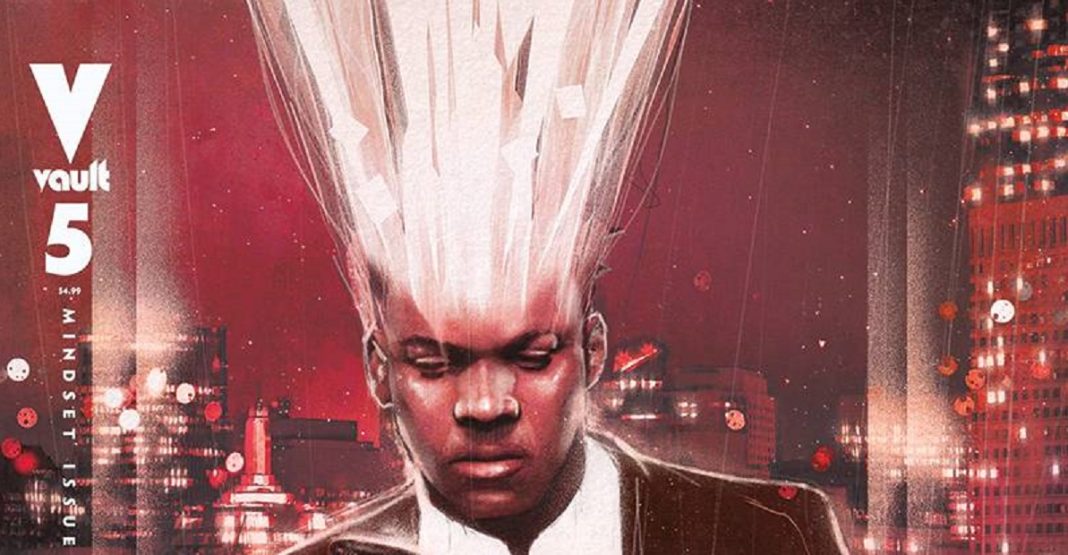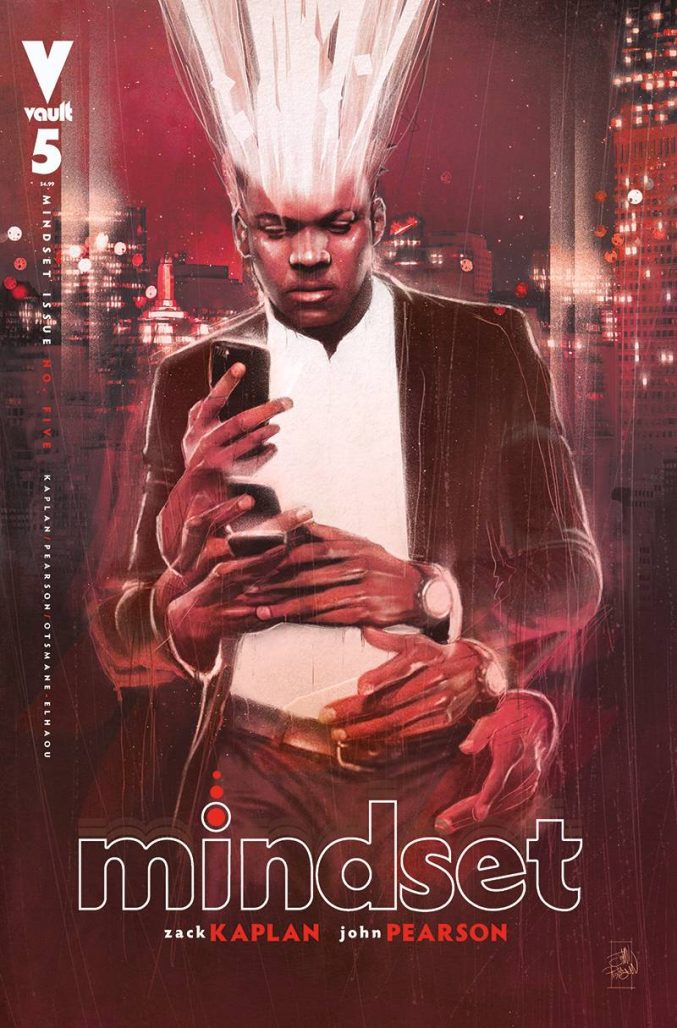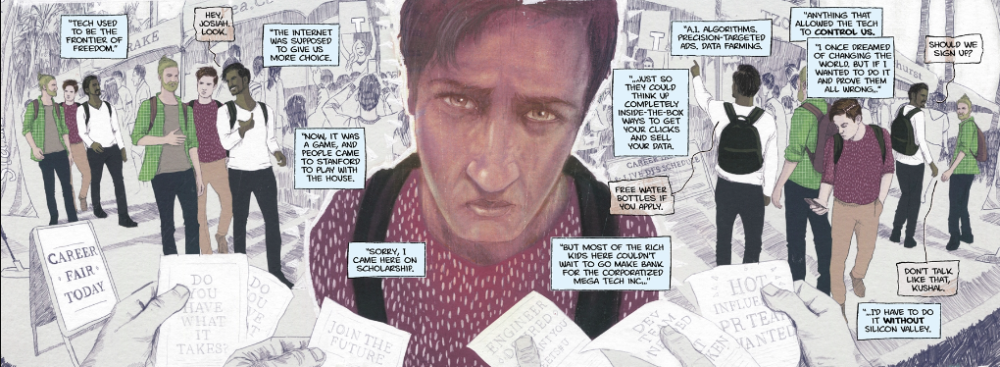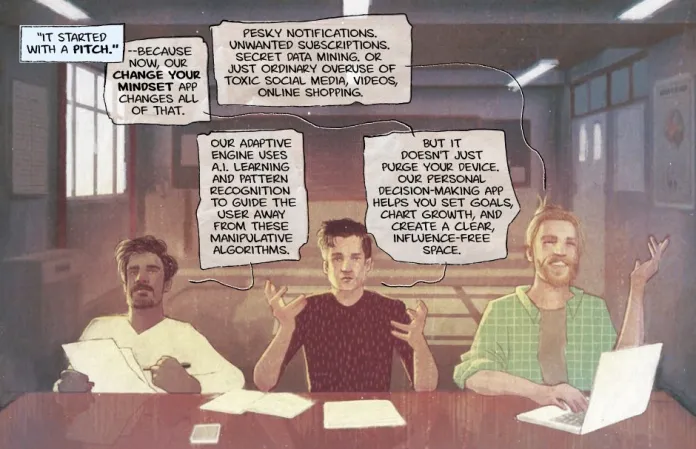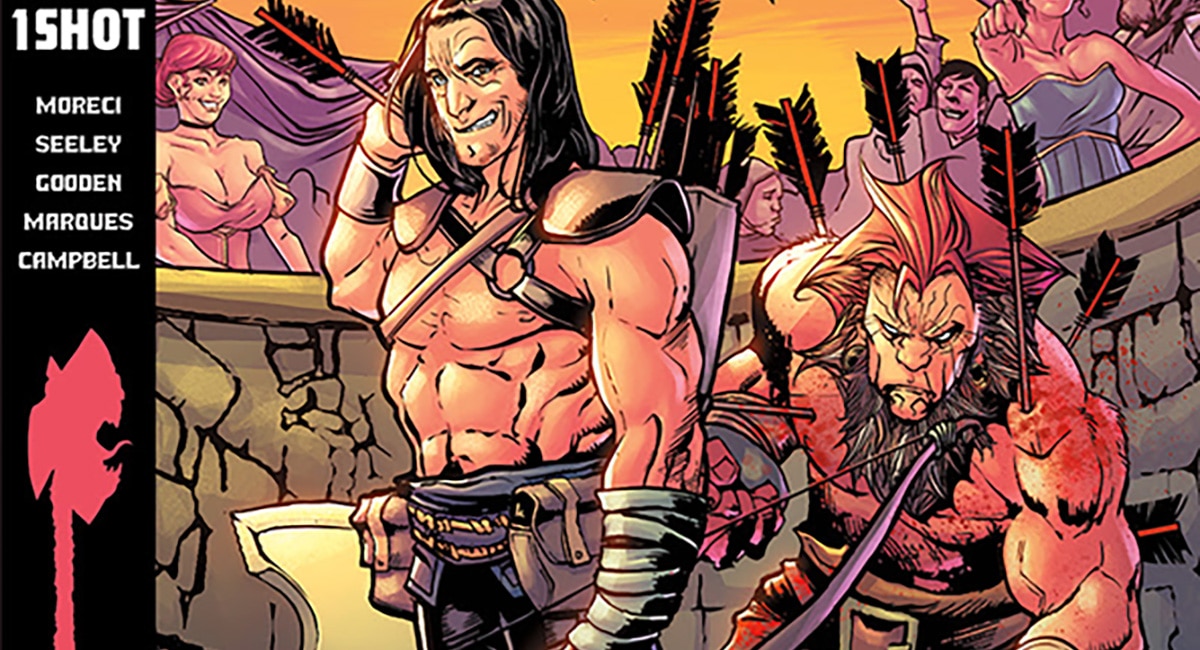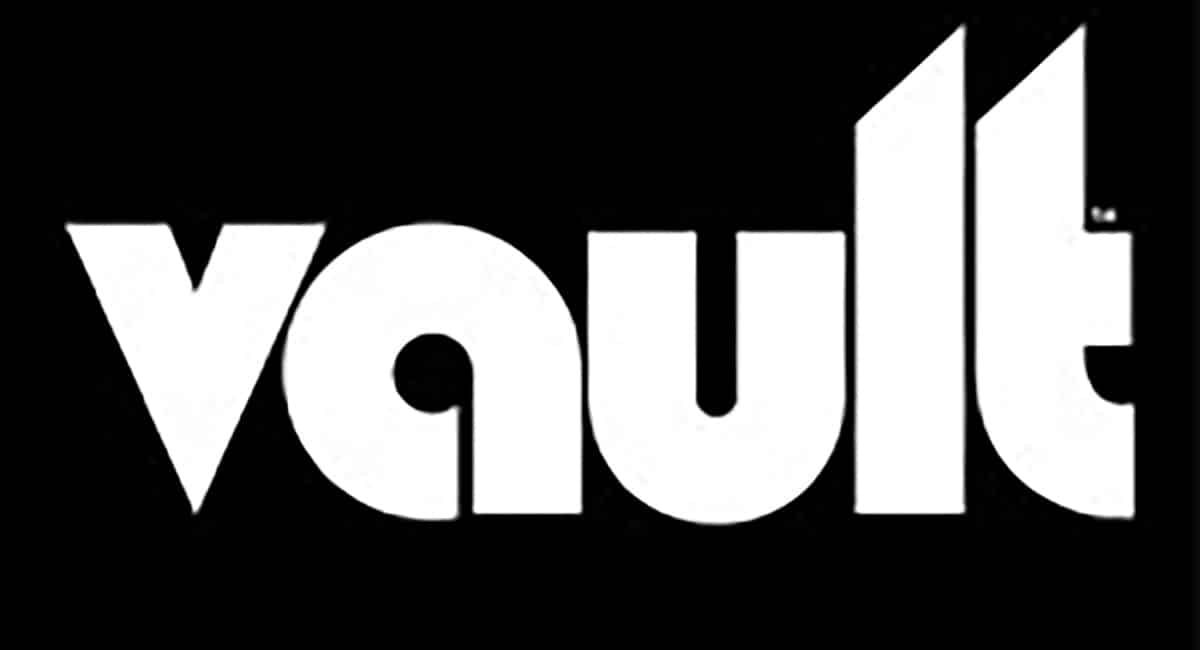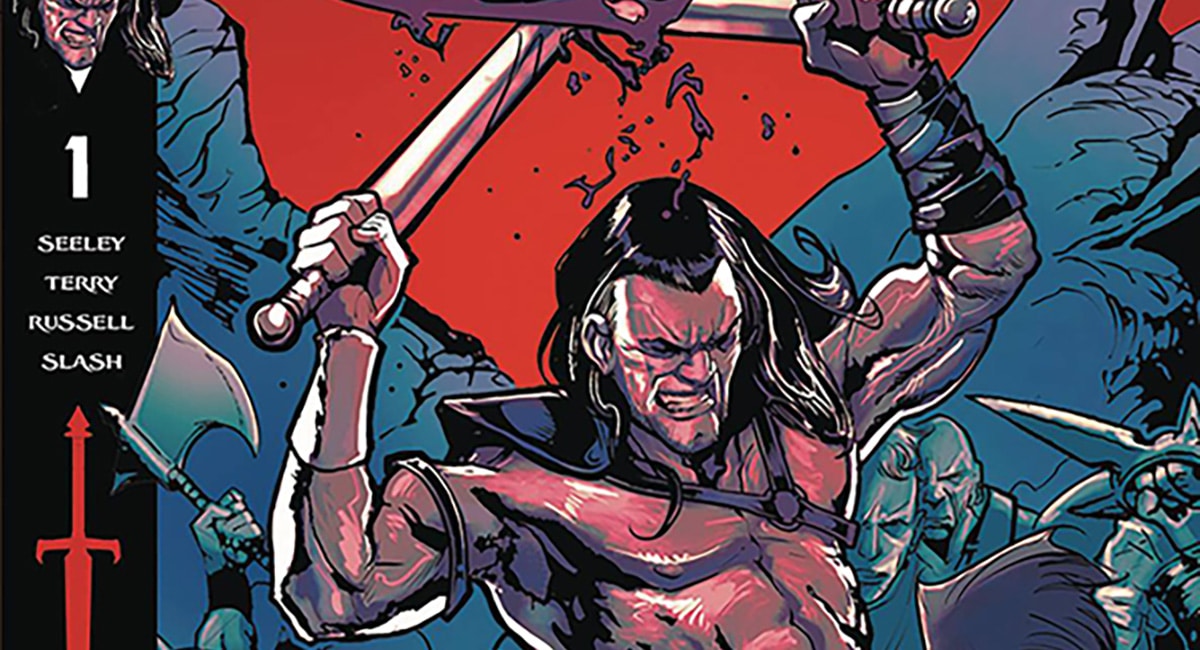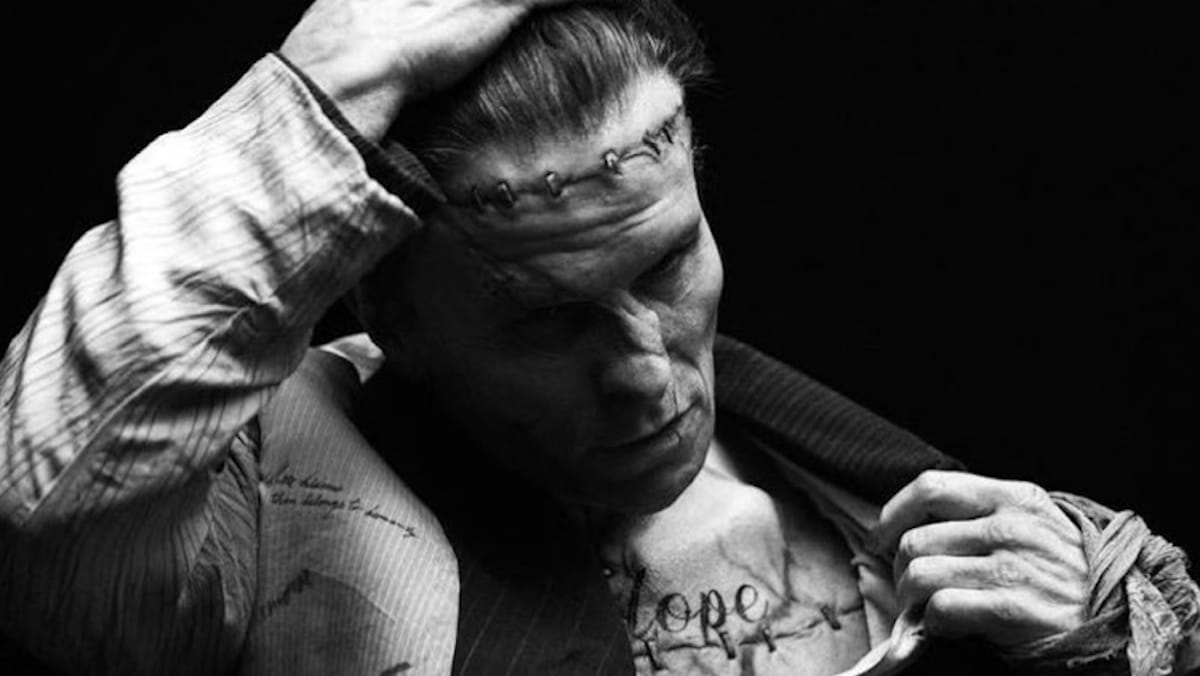Mindset is one of the best titles of the year, dealing with human insecurity and social anxiety through a lens of social media influence and tech company immorality. Writer Zack Kaplan has previously worked on sci-fi concepts like Eclipse and Join the Future that attempt to ask similar questions in the midst of a world that’s further gone than our own. With Mindset, he continues his work in science fiction, but grounds it in the reality of the attention economy.
He partners with artist John J. Pearson, who has worked on similar territory with The Department of Truth and Blood Moon. He infuses a horror influence in the style of Bill Sienkiewicz and Dave McKean to each of his books, making this story about technology all the more frightening. Pearson’s art is extremely provocative, and aids in Kaplan’s search for meaning in Mindset.
On the eve of Mindset #5, I was able to speak with both Zack and John about the book, their collaboration, the influence of real life social media addiction, and how we cope in a world driven by technological dependency.
INTERVIEW: The MINDSET creative team
STEVE BAXI: When Mindset was first announced, was there a specific moment in your life where you saw technology ruining your social relationships or did you have a rude awakening on your smartphone that made you want to do this? Was it something you had to come to over time?
ZACK KAPLAN: I don’t think there’s one moment and that’s the very essence of the problem. I think unlike other toxic or problematic influences that we might discover in our lives that can have easier breaking points, or more clear points of inflection, where we can say “this is the line,” for us, when you have something that’s influencing your habits and your daily life in a very small, manageable way, and it’s being changed ever so slowly, this is very difficult to ever hit any one breaking point.
None of us had smartphones like this 10 years ago. What has happened over the last 10 or 15 years has been a very slow boil. I think we’ve all been conditioned that we’re using our phones and using our devices, and they are controlling our life far more than we want. But it’s become a problem that we accept. The onset for me, noticing that my behavior was being changed in a way that I didn’t like was when I had children. I have two kids, and having young kids and being on your phone makes you realize that you’re not present in the moment, I think in ways than with our friends, we accept our friends are gonna be on the phone or at work. When you have children who are pretty much expecting you to be present in the moment and you are not, that becomes noticeable to you. So that to me, despite being a slow boil, that was when I was like “wow, I cannot cut this behavior of checking my phone when I’m with my kids and I’m not making this choice. There’s more to this system.” It’s insidious.
JOHN J. PEARSON: There’s certainly been situations in my life where technology has potentially amplified bad situations but it’s not necessarily a clear cut turning point for me. We’re from a generation that existed pre-internet, basically pre-mobile phones. I can remember being a kid and going from having my first mobile ringing in my bag and being confused as to what it was, to all of a sudden it being in my hands for a minimum of 4-5 hours a day. It’s hard to think about when that change happened because it happened gradually over time.
For me, the thing that makes it most apparent is looking at generational gaps. I teach as well, so I’m constantly seeing new generations coming in and their interactions with technology and how it differs from mine. And that’s actually been really good for me to reflect on how I use it. I think as well, I’ve never been one for excessively posting online or sharing my opinions online which has always been a Benefit, I think. That’s let me be a little bit more observant in seeing how other people interact and how people interact with me. That’s for me the main turning point for the potentially negative, but also positive, influence of technology over time is seeing the people around me change their interactions and that realizations of how they might of changed without me actually realizing whatsoever.
SB: Was the pandemic a moment where that encroaching of technology into your day-to-day life reached any kind of breaking point? Because now we’re obviously doing this on a zoom call and it’s kind of strange how just overnight we’ve gone through this work from home culture, everyone’s got a home office setup, everyone’s on zoom calls. There was even a piece recently about how students that get school issued laptops, if they plug their phones in to charge it, the laptops come preloaded with spyware. Was there anything like that, or your day-to-day life that’s changed since the pandemic got started?
ZK: Definitely we’re all aware that now we’re using telemeetings and zooms and remote engagement far more than we did before the pandemic. I think there’s actually a Benefit to that in some ways. This very call is a testament to that. I don’t think that’s really where technology gets you, technology doesn’t get you with the basic function that it first offers. Technology gets you by subversively and overtime wearing you down so that you’re dependent and ignorant of that dependency on the very thing. So suddenly if you’re doing zooms all the time and someone says “let’s do a coffee,” you go “ah people. Places… I couldn’t possibly do something like that. Let’s just do a zoom. I like the comfort of my own office” That’s where the problem comes in. There’s the “I don’t like people, I don’t want to go to meet people in public places anymore, how did that happen?” We’re all had that experience throughout the pandemic where we find ourselves adverse to ordinary situations that we were not previously adverse to. So you go, how did my habits change? How did my dependency on daily life change? And the answer is you were offered alternatives that you became comfortable with. You were offered “you can watch this movie, or you can look at a million TikToks” which are faster and interesting, and so someone is looking at TikToks while they’re watching a movie
The layer at which you bring up spying on people who are using their phones, or using people’s data, using people’s experience against them to buy their attention, to buy their clicks, that’s a whole separate, equally troubling, aspect of this where we’re giving our attention, our privacy and our lives to technology companies. And we’re trusting them to just provide goods and services and not to manipulate that access, and that doesn’t always happen. That is also separate from the addictive dependence that we are looping ourselves into on our own. So we are both being manipulated by tech companies at times but also by ourselves, and just the way in which we interact with technology which is programmed and designed to get ourselves addicted. There are layers on top of all of this and it’s worth parsing out. The pandemic has exacerbated the change in our habits in troubling ways.
JP: The pandemic highlighted the simultaneous positive and negative aspects that have always been with the technology that we’re exploring in Mindset. On one hand, it allowed us to connect with people easily that we can’t see, and not just locally but internationally. On the flip side of that, it means you don’t necessarily have to see people in real life anymore to feel like you’ve interacted socially, and that’s a real issue. With teaching during the pandemic with that cohort that had a year online of not interacting with people face to face. And when we got back to trying to have normal interactions, it’s really, really difficult because you feel like you’re meeting people for the first time. It’s a real issue, that dependance, during the pandemic, was thrust upon us. I don’t think anyone saw the negative impacts until now where you realize that it is something you can’t live without. I’m guilty of it myself. It’s great that I can Facetime my mom, and speak to her but I’m not seeing her, I’m not having a real life interaction. It’s completely bizarre.
I met Zack for the first time in New York, a few weeks ago and that was the first time we met face to face. It feels like we’ve known each other for ages cause I have. This whole whole collaboration wouldn’t have happened without but it feels bizarre to me that’s the one and only time we’ve met.
ZK: I zoomed with you more for Mindset than any other artist that I’ve worked with. I’ve worked with eight different artists but John and I are both English-speaking, and it was just second nature to zoom based on how we built this collaboration. So we zoomed and engaged a lot doing this, and it made it, I think all the better. So despite all the hardship technology is causing the whole world, we made a good comic and that’s all that matters at the end of the day
JP: [laughs] yes!
ZK: As long as we make a good comic and sell it, it’s okay if we sell our souls to technology. [laughs]
JP: We’ve made a comic book that’s not necessarily talking about the horrors of technology, it’s talking about the duality of it. This is what it all boils down to, that technology is not inherently good or bad, it’s how people use it. We used it amazingly [laughs]
ZK: You get into the framework for how we created and structured the story, and it’s actually about some characters that start with some ideals and some hopes for how technology could be used and it’s a question of can that work? There’s a lot of different ways to structure a story about a group of grad students who discover mind control and put it in an app, but in order to properly, thematically explore “is it technology, is it us,” I think you do have to start with the hope of what it could be so that you can get to the dangerous of what it should not be.
SB: Getting to the grad students in particular, with Ben and his friends in Mindset, and the idea that they all seem to understand from the onset that technology is mind control on some level, so creating an app that’s literally mind control to ostensibly help people get away from that behavior, that is a very tech bro, silicon value behavior, the idea that if technology is doing this to us, more technology will just fix the problem. In crafting these characters, were there any people in real life or any companies that you saw that you tried to infuse in? Obviously the story of Mark Zuckerberg and Facebook that became famous with The Social Network, but even just his more active public appearances in the last few years, was any of that feeding into Ben Sharp in Mindset, either visually or emotionally?
JP: Visually with Mindset we wanted Ben to be a normal person, a kind of every day almost forgettable person. Which is really hard designing a character that doesn’t really have anything distinguishing about him. We went through quite a few interactions with Ben, more so than any other characters because we wanted something that had a combination of that youthful energy but also naivety but also could be multifaceted and have lots of layers to him. So almost this blank slate of a character where we could take him through a whole multitude of experiences that in some ways could reflect him but also reflect the experiences of us and readers as well. There’s also all the kind of stereotypical look of tech bros and all that stuff that feeds into it. With Ben especially it was a difficult character to design [laughs] just based on the lack of anything top distinguishing about him
ZK: In terms of the zeitgeist of what is out there, definitely trying to emulate the broader ideas we have about a startup and a tech entrepreneur. Because I think by emulating it, we’re kinda grounding it in the real world a bit. Now obviously some of these things are stereotypes and there’s a broad swath of people who are tech entrepreneurs. I don’t know exactly the nuance of what we’re drawing from. Obviously the Social Network and Mark Zuckerberg and Facebook set the ground level of it, it’s become this whole other thing in the era of Elon Musk.
I focused more on the character in Mindset who would be looking at this situation. Ben is a really flawed and interesting character study that I think we all relate to because on the one hand, he hates technology and social media and what it makes him feel. And at the same time, he does not want to walk away from it. He desperately wants to use it to change how he feels, and to feel better about himself. In this way, these designs are really not so much about trying to copy something that we saw out in the public as much as trying to create a character that mirrors the feeling that we all have when we check our phone, which is how we don’t like looking at social media and seeing other people’s fancy lives, and feeling inadequate about it. We know the trick but we still can’t help but get emotionally affected by it. But then we don’t put our phone down and instead we post how great our meal looks or something silly that we’re trying to complete to feel like we matter, to feel like we are influential.
So I think it’s a very interesting dynamic, the phone usage, the device usage, the relationship with social media, the relationship with each other. A lot more of the character work I went into in Mindset was trying to give Ben a childhood and a past that built up to that story. Trying to give him a moment in the present that kinda captured all of that, that gave him these very complex, conflicting desires. And then from a visual standpoint, just to make him a real blank slate and somebody that kinda had the opportunity to succeed but got in his own way. Just so we can see that he is the problem in a lot of ways. Mindset kinda takes a mind of its own. And if people have caught up with the story, they come to realize Ben started with a sense of ideals but he’s also got other driving forces, the desire to be seen and the desire to be on top. So where Mindset ends, Ben is culpable in all that. We didn’t look too much at what’s out there in terms of tech companies and other entrepreneurs to try to mirror anything in particular.
JP: There was a general to rush to make things believable and kind of accurate. Especially in terms of the tech world. Cause I know a few times with the scripts in Mindset, we were like “would they refer to this in that way or would it be this way?” to make sure it did have the grounded in reality for that industry and world. I think the grounding in reality of the story, for me, works so well and lets me do something that’s starting to get removed from reality. So it’s that kind of linchpin for what the general industry and general believability without it being too specific as opposed to any examples that would be in the forefront of anyone’s mind. Cause if I think we did that, it would detract from it. It would make it something else. I think people would get caught up on that a little bit.
SB: How do you guys work together in creating the specific look and feel of Mindset? Because artwise, there’s this sense of a horror comic tradition happening. John, I know you’ve mentioned in the past you’ve had influences like Bill Sienkiewicz and Dave Mckean in getting this more gothic aura to it. There’s a lot of silhouette work here and a lot of interrupted panel boundaries. How much of that is going back and forth in coming up with what a page needs to look like vs how much of it was paneled for in advance in the script?
JP: It really varies. I think Zack and I collaborate quite closely throughout the entire process. Zack talks to me all the time because we’ll have meetings about the premise of the issue, and we’ll go through the script, and we’ll go through the layouts. And they’ll be specifics that Zack will come up with, very cool visual ideas. And that’s something as well that’s developed the more that Zack’s got used to my approach to visuals. A lot of it will be me kinda using visual ideas that I’ve established earlier on in different ways. With this series especially, a lot of things like silhouettes, it’s established right from the fourth page in the comic book, it’s just used for different contexts and manipulating that throughout. So the collaborative process with this is I’ll talk to Zack exactly why I’m doing things for specific reasons, and it’ll be rare that I’ll do something just because it looks. I’ll do something because it looks cool but also for this reason for the story which is kind of where I think the collaboration is so close between us, because its not just I get a script and I draw it. It’s way more unified than that.
ZK: Especially for a comic like Mindset, everything to me is better with meaning and purpose. Any layout or any scene, I always like to come into and say how can evaluate and enhance the emotionality, the thematic meaning of this scene? Is this a scene of chaos, is this a scene of claustrophobia? Is this a scene of just heart? What is going on here and how can we accentuate that? I’ll slowly try to build that into my layouts but early on I realized how versatile John and the layouts and the paneling was. I think by issue 2 or 3 we were already collaborating, I even started to connect John before I’d script and say “here’s the shape of this issue, and here’s a scene, and I’m thinking this is a double page, I’m thing it’s like this,” and weigh in before I write it. “I’m thinking this could be built into multiple panels, more chopped up. What do you see?” And giving a chance to kind of find the right path together even before I go to script it, and then scripting it and bringing that back to him, letting him play with that, coming back to see if there’s any missed opportunity or any ways to elevate it again. I think most comic teams don’t go back and forth as much, maybe they do, but we’ve found by going back and forth more, between script and art, we’re able to find more opportunities to bring out some of the things that seem to be working for the story.
JP: My focus is always on emotional connection with the art. It makes sense that would be discussed earlier on in the process because the emotional connections, especially in this story, is one of the fundamental ideas we;re trying to explore. Ir also means from the start I know what zack’s intentions are, it can genstating in my head before I’ve even gotten the script, and I can be thinking about interesting ways to express certain scenes, or where to show more or less detail
ZK: Mindset has a lot of subtext and a lot of double entendre, in terms of what’s going on in the surface and what’s really going on. Being able to convey the subtext, because it may not always be in the script. First read you may not get. So being able to say “hey john here’s what’s going on in the scene, it’s not in the dialogue, but here’s what’s reeling going on, and then him being able to draw that and that comes out through the art so the reader can read the text and have one experience, and see the art and feel that subtext, that’s a really powerful tool. Especially this story requires me to say: “Actually in this scene, they’re all zapped and they’re under mind control but we don’t know that by anything that’s been said.” John can then bring out a whole different layer. This person is feeling completely dejected even though they’re talking oppositely.
JP: That’s why I had so much fun with this. My approach is, I’ve a real fluidity to how I do sequential art. Well how can you show it without actually showing it? It’s just in a different style, its can signify difference without me drawing something like the mind control zap or something like that. Its good that we’ve established ways in which we can show that subtext without it being really explicit.
SB: Hassan Otsmane-Elhaou is doing the lettering on Mindset, which is also incredible and really unique with the way it has that blue tinge to make it feel like a cell phone screen as you’re reading inside Ben’s thoughts. How did the three of you begin to work together and where did the visual language for Mindset come from?
ZK: I worked with Hassan on Join the Future, and I just love his risk taking, and his creativity when it comes to lettering. He’s really excited to make changes and do very interesting things. When we were talking about letterers, I said I’d love to bring this to him. We told him a little about the story, and he approached it with so much intention. There’s this translucent-ness . I remember when he first sent over some sample ideas of using a level of opacity in the balloons to signify the very essence of looking deeper, this theme that’s going through the story. And these thin tails which make it feel more like a screen, and less like a text classic dialogue balloon. There’s some really brilliant intentional choices that just blend into the story. But when you actually stop and analyze them, they just enhance everything. And I’m writing a very verbose script with a lot of Ben’s inner’s thoughts, on purpose, to give you a sense of feeling completely bombarded by this guy’s emotionality to parallel to technology. So asking Hassan to artfully canvas that across John’s artwork, he’s putting on a masterclass, its amazing stuff
JP: I first worked with Has on a short I did for Razorblades. We kind of chatted about the approach for that and it was completely different to this. The beauty of Has and the genius of him is that he’ll always strive for something that’s sympathetic to the art style. For a style like mine it has to be like that. If you just had a traditional balloon approach, it would stand out like a sore thumb. With Has he’s acting as basically another artist on the book because he works so hard to make the lettering specifically fit in with the weird art that we’ll do. But more than that he’ll add the details to the mindset zaps, and the weird squiggles. You wouldn’t even think the letterer would have done that but he’s so invested in pushing the communication of Mindset even further. We’ve got the script from Zack and then it will be translated into the weird artwork, and then Has would just push even further with what he does. I’m always astounded to see how he manages to fit in some of the stuff from the script.
SB: You get a real sense with Ben that this is an anxious kid, this is a kid who grew up in a household where there’s always a level of performativity, make sure that appearances are out there. He’s got a lot of double talk where he goes back and forth with his mind a lot. The lettering coalesce around him so you feel that anxiety. The artwork allows you to have a lot of silhouette so it feels like he’s always out from the rest of the pack, that’s always missing out on real human connection, and he’s always reaching out towards that. Was the choice to ground this as a grad school start rather than an established company with an older character related to trying to convey that anxiety? Does his age and blank slate appearance as just a kid that got in over his head was part of making the story feel real?
ZK: Yes. There are different emotional situations, there are different raw feelings we all have that make us feel like certain times and eras at different parts of our lives. I think the quintessential wanting to to be seen, wanting to feel part of the world, is a very early 20s kind of experience. We all feel it throughout our lives, but when you feel it, for me, nothing reminds me of that more than coming out of school and facing the real world and trying to find your place in it. Because at least in school, you are pre-set as part of that community. You’re whole like you’re told you’re part of this family, this street or school. And then finally you’re done with school, and you’re sent off and they say “find your place.” That period and that emotional raw pre-set feels very much like a relationship with technology, where we’re given the technology and we’re told “find your place. You are a nobody standing on the side lines. Everyone is living their fancy wonderful lives full of love and friendship and happiness. And yours doesn’t compare unless you think it can, use the technology.”
I don’t think it would’ve been the same to start him already established and see them pivot. I feel like it needed to be a rags to riches, a startup. You had to see where Ben was feeling like he had nothing and understanding and relating to not only that but his ideals to do something positive with technology. I think that first pitch meeting he has in that very first issue where he’s pitching to Winfield and all of these tech moguls and he’s saying I just want to do something that will help people. And they’re saying that’s not how this works. We need you to use the data, or get some celebrity voices, or this or that. Why can’t it just be helpful?
He wants to do good, but he wants to be part of the system. In terms of engineering a story to be this startup and to see Ben graduating, that’s an intentional choice. Finally putting education behind him, entering the real world and having that before him was all meant let the reader empathize and relate and step into that emotional arena that we’ve all been in before.
JP: The older you get, your relationship with technology completely changes and changes very quickly. When you are in your early 20s, you have a lot of conflicting, not only emotions, but outlooks on your life. You’re simultaneously overly confident and completely unsure of yourself. Its the end of one part of your life and probably the first chapter of your life. You’ve gone through your entire education and now it’s just gone and that’s all you know and it’s the beginning of something else. So Ben’s there with all these conflicting influences on him, both internal and external. It’s perfect for him to approach something new with a potentially misguided viewpoint. It wouldn’t have worked if it was someone that was already established, because it has to be somebody that is an underdog. They need to feel seen, and they need to feel a sense of control over themselves and the world around them. And that’s what everybody strives to do when you’re in your early 20s. You need to form your own identity to carve out a piece of the world for yourself
SB: He had to have his friends, and these areas of power around him that pushes him in directions he didn’t choose for himself. You open the first issue with the threat of not graduating and needing someone who will let him into the lab just so he can finish his last project. The idea that he and his friends go around testing this app together and create a community for each other where saying no to anyone in the group feels wrong, even if it’s the morally right thing to do. Did you create each of these side characters in Mindset to get into Ben’s head, more metaphorically, or was any one of these characters someone who could be the new main character?
ZK: Definitely not the latter. I don’t think they were carved out to be satellites to Ben. I think they were carved out to show other drives we have when we engage with technology. Josiah is seeking to find a normal, ethical footprint in the world and he wants to use technology for that Benefit. I think Kushal’s got a very subtle voice, but I think he’s looking for truth. Eitan I think was to created a bit more to be some of the things that Ben wants to be but cannot and looks up to and admires. In the sense that Ben cares what everyone thinks and aton cares what nobody thinks. Eitan was designed in a lot of ways to be kind of a good partner for Ben as the story goes on. And then also a potential foil. They were all created with different ideas. Ben is really this dreamer desperate to be part of this system, yet also carve out his own lane. He’s a very particular character and any of these other characters would have made it a very different story
JP: For me, it’s all about their power dynamic. With these silhouettes which all fluctuate between them. They’ll go from being very unified, to being very alienated. They’ll be certain scenes in Mindset where they’re having a conversation and the panel boarder divided that conversation. They are for me one and the same entity, I suppose. But that goes back to what Zack was saying, they’re different aspects of our different relationships to technology. From a storytelling point of view, its all about Ben, they’re just representative of the balances, I suppose, of a lot of our interactions
SB: There’s a lot going on in Mindset and it’s hard to believe we’ve only got 2 issues left. I want to end on a more personal upshot. You’ve written Mindset and created this story that’s all about the dangers of technology that goes unchecked in our personal life. As people that are writing, cerating, have to be by your computer all your time, you have to be by your phone. How do each of you try to disconnect to stay mentally healthy now that you are so aware how on the clock you are at all times? What’s your way of staying sane?
JP: Who says we’re sane? [laughs]
SB: What’s your way of hiding that you’re insane?
JP: It’s really hard. I’ve got my phone where I’m looking at stuff or I’m on the computer all the time. It’s really, really difficult. I think for me, I’ve recently gotten a dog and that’s amazing for getting out of the house. Its something I have to do to remove myself from it. When it comes to work, especially when there’s deadlines, sometimes you have to be permanently clicked in. I started to put my phone on sleep mode so you don’t get notifications, trying to come up with a reasonable time where its just “I’m just gonna disconnect now, I’m gonna sit down and read a book, have some human interactions.” There’s no set way to do it, you’re always dragged back to looking at your phone. And you don’t even realize it, you’ll set your phone down for the night and suddenly you’ve been scrolling for 3 hours, hows’ that happened? It’s a necessary evil sometimes. As much as I’d like to engage with technology less, I constantly find myself engaging with it more out of necessity.
ZK: There’s a line that I put, it’s funny as a writer you’re writing and I don’t think about trying to write significant lines. I’m just writing dialogue and writing random stuff and trying to get it to flow. But then you find something and go “wow! That sticks, and that’s a significant point” and you end up using it again. One of the things I’ve ended up using throughout Mindset is this idea that when you know you’re being influenced, then you have the power to change your mindset. I don’t know, what do the readers think? Do you think if you know your phone is controlling you to use it, if you know that, that you can disengage? Because I know that I have tried to come up with these habits of “I’m not gonna check my phone in the evening when I’m getting into bed” or I’m not going to look at my phone in this 3 hour window. And then a month later somehow, that rule gets altered, you get pulled back into the vortex of usage. I know that I’m being cooked alive [laughs].
I try all the things that everyone tried: take walks, take breaks, put the phone down, change the notification settings yadda yadda.
It’s a question we haven’t figured out, and we’re all trying to reduce our usage but I don’t think knowing and trying always gets us there. It’s a real modern challenge. Which is why I think Mindset has struck a nerve with some of the readers. Because they’re going through that, and they’re like “I get this, I know that. This is scaring me and yet I can’t do anything about it.”
Mindset #5 (of 6) is in stores November 16, 2022.


